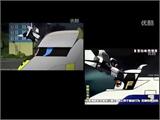The foreign objects that cause inflammation in delinquent boys and bespectacled girls can be eliminated from these areas. Note: The original sentence seems to mix a casual/trendy description with a medical or health-related statement, which makes it somewhat nonsensical or humorously out of place. Please double-check the context or provide more details if needed for a more accurate translation!
The broken knife was taken out.
The broken knife was surgically removed.
The broken knife is over 10 centimeters long.
This 10cm long broken knife was inserted from his right jaw, sequentially passing through his tongue root, nasopharynx, muscles, and finally had its tip embedded in the brain.
What does it feel like to have a 10-centimeter-long small knife stuck in your head? A 37-year-old man named Li Fu (a pseudonym) from Yuanjiang, Yunnan, probably has a deeper understanding than anyone else. This Hani man, who was often troubled by problems such as bad breath and headaches, discovered during a check-up in January this year that a small knife had been embedded in his head!
Not only Li Fu, but even the doctors at the People's Hospital of Yuxi City, Yunnan Province were stunned when they saw him. "A knife actually existed inside the cranium for more than four years among dense nerves and blood vessels, which is truly an amazing miracle," said Luo Zhiwei, the director of the Neurosurgery Department, who also expressed his amazement to the reporter.
From 8:30 AM to 12:30 PM on February 12th, after four hours of intense surgery in the operating room of the People's Hospital of Yuxi City, the doctors successfully removed a 10cm long, 1.8cm wide, and 0.24cm thick broken knife that had been lodged in Li Fu's head. It was understood that this 10cm long broken knife was inserted from his right jaw, sequentially passing through his tongue root, nasopharynx, muscles, and finally had its tip embedded in the brain.
The reporter observed that the two ends of the broken knife extracted from Li Fu's head were still intact, while the middle part had already been corroded. Dr. Luo explained that the corroded part was located within the pharyngeal cavity, where the secretions of the oral mucosa are acidic and can corrode the knife body. When the doctor cleaned the broken knife, the strong stench could be smelled even from a great distance.
At around 10 o'clock in the morning on the 13th, the reporter met Li Fu lying on the neurosurgery bed, whose condition had stabilized at that time.
The broken knife remained in the head undetected for 4 years.
According to the patient's younger brother, in 2006, Li Fu supported himself by driving a motorcycle to ferry passengers. On the night of September 21st, Li Fu responded to a passenger's request and ferried them from the county town of Yuanjiang to Gan Zhuang. Upon reaching near Gan Zhuang, the passenger suddenly pulled out a knife and robbed Li Fu. During the struggle, Li Fu's right jaw was stabbed by the knife. After being stabbed, Li Fu stopped resisting, and the suspect took away his belongings and motorcycle, after which Li Fu reported the crime. The injured Li Fu was sent to the local hospital in Yuanjiang County. Due to the limitations of local medical technology and equipment, no examination revealed the presence of a broken blade fragment in his cranium. After cleaning and suturing the wound and administering anti-inflammatory injections, Li Fu's wound gradually healed without any other symptoms, so he did not stay in the hospital or undergo further examinations, never expecting that a piece of the knife would remain in his head. Later, the police caught the criminal who stabbed Li Fu and informed the family that they had found the handle of the knife used by the suspect in the crime, but the blade that should have been attached to the handle was never found.
Li Fu's injuries gradually improved, but ever since then, Li Fu's mouth frequently became inflamed, accompanied by symptoms such as bad breath. His wife said that after the injury, her husband's mouth always had inflammation, requiring frequent anti-inflammatory injections, which couldn't cure it, making it impossible for him to work. He idled at home for one and a half years, later setting up a stall in the county's farmers' market to sell miscellaneous candies. After recovering from the injury, her husband's voice became hoarse compared to before. When his condition was better, he could drink alcohol, smoke cigarettes, and even use a water pipe, but his mouth frequently became inflamed. For more than four years, he intermittently experienced headaches, oral bleeding, and underwent "anti-inflammatory" treatments. When the inflammation flared up, he wouldn't eat anything, not even porridge or soup.
While treating oral diseases, a broken knife was discovered in the cranium.
Unable to endure the long-term irritation of oral inflammation, on January 24th this year, Li Fu underwent an X-ray examination at the hospital in Yuanjiang County and was informed that there was a 10-centimeter metal object in his head. At the time, Li Fu and his family suspected whether the doctor had made a mistake, so they decided to go to the hospital in Yuxi City for confirmation.
Dr. Xu Wen, deputy chief physician of the stomatology department at the People's Hospital of Yuxi City, said that at the time, she treated the patient Li Fu brought by the doctor from Yuanjiang County Hospital in her outpatient clinic. From the X-ray taken at the Yuanjiang County Hospital, it could be seen that there was a very clear metal object in the patient's cranium, but it was unclear what the object was. Later, more precise CT and vascular imaging examinations were conducted on the patient, confirming that there was a 10cm long broken knife in the patient's cranium. The fact that the patient could still smoke and even use a water pipe despite having such a long foreign object in his cranium surprised Dr. Xu.
Why could the broken knife remain in the patient's cranium for more than four years without causing severe pain or even threatening life? Dr. Xu analyzed that when the knife passed through areas with channels such as the throat and mouth, the inflammation produced expelled the foreign object from these areas, preventing the worsening of the condition to some extent. Therefore, the patient could maintain this state for so long, which was indeed a miracle. After examination, Li Fu's reactions were normal, his expressions were relevant, his left temporal muscle was atrophied, his voice was slightly hoarse, his pharyngeal reflex was overly sensitive, his right tonsil and pharyngeal soft tissue were red and swollen, deviating toward the midline, while other neurological examinations showed no abnormalities. The diagnosis was a knife wound to the base of the skull, throat, and lateral neck with retained metallic foreign body; chronic inflammation of the right submandibular gland and lateral neck area.
Dr. Wang Heping, the attending physician in the neurosurgery department, said that when the knife entered the patient's head, it avoided important facial blood vessels and nerves. However, chewing and swallowing by the patient would cause the remaining knife to shift position. If the shift cut other nerves or blood vessels, it would endanger the patient's life. Fortunately, the knife moved parallel along the direction of the facial artery during the shift, so it did not cut the artery. If the knife had moved perpendicular to the facial artery, it would have caused serious consequences of the artery being cut and massive bleeding.
According to Dr. Luo Zhiwei of the neurosurgery department, it is understandable for objects like needles or nails to be inserted into the human brain and still survive, but for such a long broken knife to enter the patient's cranium and the patient to survive for more than four years is indeed a great miracle. This broken knife was inserted from the root of the tongue, tilted upward, passed through the nose, pharynx, and muscles until reaching the left brain. There are many nerves in the human face, and the knife avoided the cerebral artery and some important facial nerves when entering the head, avoiding major consequences such as facial paralysis or massive bleeding. Dr. Luo Zhiwei said that this was something he had never encountered in nearly 30 years of practicing medicine. The patient survived due to the narrow margin, which was a great stroke of luck for him.
[Question]
The Dangerous Surgery
The metallic foreign body was located in front of the large blood vessels in the neck, about 3.5mm away from the cerebral artery. The tip penetrated approximately 1.3cm into the bottom of the left temporal lobe brain tissue of the cranium, with mild edema and inflammatory changes around it. The main body of the foreign object at the base of the cranium, near the tip of the knife, was located between the round hole and the oval hole, adjacent to the trigeminal nerve, maxillary artery, and facial artery, making the surgery very challenging. Prior to this, the People's Hospital of Yuxi City had not encountered such a special case. Despite the broken knife being in the patient's cranium for more than four years, the patient was able to live a normal life and perform labor, largely unaffected, and could even drink alcohol and smoke pipes. However, this surgery carried significant risks, and if an accident occurred during the operation, the consequences would be unimaginable. Nevertheless, after learning about the presence of a metallic foreign body in the cranium, Li Fu exhibited anxiety and anger, showing a strong desire for surgery.
Before the surgery, the entire hospital organized a grand consultation considering many surgical plans, including removing the knife from below the jaw or posterior to the jaw; if the eroded knife blade broke, performing a craniotomy to remove it; or removing it via the nasal cavity. After consulting with the patient and their family, the hospital decided to proceed with the surgery, as stated by the online user "Nanjing Xiaoliang."
The surgery was jointly performed by the stomatology and neurosurgery departments. Since the location of the knife was surrounded by blood vessels and nerves, and was deep, cutting the cerebral artery during the surgery would result in uncontrollable bleeding, leading to shock and death. Under the assistance of a microscope and a neuroendoscope, Dr. Xu Wen from the stomatology department incised the patient's right lower jaw, passed through the inflamed area, and located the tail end of the broken knife seen in the radiographs. From the start of the surgery to the exposure of the broken knife, it only took one hour to complete. After exposing the broken knife, considering that the blade was very thin, only 0.24cm, and the portion passing through the pharyngeal cavity had been severely corroded, breaking during removal could make it harder to extract the tail end, endangering the patient's life. Dr. Luo Zhiwei from the neurosurgery department carefully separated the connecting tissues around the broken knife, ensuring no nerve entanglement, and successfully removed the broken knife from Li Fu's cranium.
[Reminder]
At 9 o'clock in the morning on February 13th, the day after the surgery, the reporter went to the neurosurgery office of the People's Hospital of Yuxi City. Dr. Luo Zhiwei displayed the films taken at the time and the broken knife extracted from Li Fu's cranium on the computer. The two ends of the broken knife were still intact, while the middle part had been corroded. Dr. Luo said that even when cleaning the broken knife from a distance of nearly half a meter, he could smell a strong stench.
Dr. Wang Heping from the neurosurgery department said that post-surgery, the patient was washed, drainage tubes were placed to remove bloody water, and currently, the patient's condition was stable, out of danger, able to talk with clear consciousness, needing more than half a month for postoperative recovery.
Regarding the situation where Li Fu had a knife hidden in his head for more than four years without being noticed, resulting in continuous oral inflammation and suffering, Dr. Wang Heping said that when people encounter personal injuries or accidents, they may not notice foreign objects in their bodies due to the chaotic surrounding environment at the time and their own tension. It is best to choose a reputable local hospital for examination to ensure no foreign objects remain in the body.
According to Chengdu Evening News



